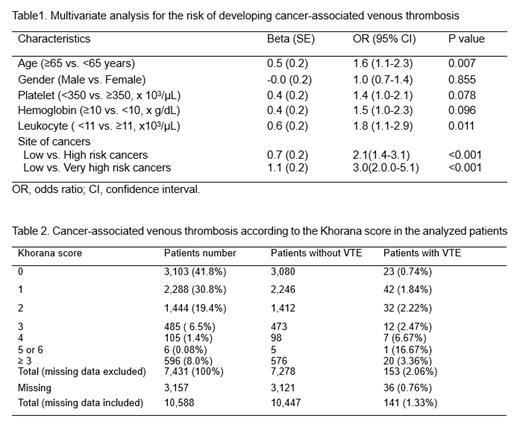Abstract
Khorana score has been the most widely used for the prediction of cancer-associated thrombosis (CAT) and recent pivotal phase III trials including AVERT and CASSINI adopted Khorana score in the inclusion criteria. However, most studies in development and use of Khorana score were conducted in Western cancer patients. The prevalence of VTE is known to be substantially lower in Asians than in the Western population. In case of body mass index (BMI), experts suggest an adjusted cut-off points of the classification of weight status in Asian population since they are usually thinner than Westerners. In addition, risk of CAT according to the sites of cancer may need reassessment since the characteristics of each site of cancer varies among geographic regions or ethnicity. For those reasons, we thought that Khorana score needs to be separately validated in Asian population and conducted a retrospective real-world analysis.
By using the Observational Medical Outcomes Partnership Common Data Model (OMOP-CDM), we collected de-identified data of the newly diagnosed cancer patients who underwent chemotherapy from January 2016 to June 2019 at Seoul National University Hospital (SNUH), Seoul, South Korea. Patients were eligible if they 1) had a new diagnosis code of cancer and 2) had initiated chemotherapy within 3 months after the first recoding of the cancer diagnosis. The patients undergoing chemotherapy were identified based on their prescription of chemotherapeutic agents and the procedural code for the first-time patient education for chemotherapy. Among the selected cancer patients, values of complete blood cell counts (CBC), body weight, and height on the very day of or the day closest to the chemotherapy initiation were obtained. A patient was counted as having a VTE if he or she had both newly-recorded diagnosis code of VTE and new record of anticoagulant medication code within 1 week after the emergence of VTE diagnosis code. Cumulative incidence of CAT was estimated at the time of 3, 6, and 12 months after the date of chemotherapy initiation.
A total of 10,588 patients with cancer and chemotherapy were eligible and only 1.33% (141 patients) had a CAT at 6 months after the chemotherapy initiation, suggesting lower overall incidence of CAT in Asian population. Pancreas (4.9%) was the most common primary cancer site but CAT incidence rate in patients with stomach cancer was limited to 1.6%, reflecting different characteristics of the disease between the East and the West. The CAT incidences in patients with lung cancer (1.4%) and lymphoma (1.1%) were lower than expected, in line with a recent meta-analysis (Mulder at al.; Haematologica 2019), but CAT incidences in patients with liver (3.4%) and biliary (3.0%) cancer were higher than expected considering the Khorana scoring system.
Among 7,431 patients who had all data for the calculation of Khorana score, 5,549 patients (74.7%) had a BMI of < 25 kg/m 2, followed by 1,633 patients (15.4%) with a BMI of 25.0-29.9 kg/m 2. Only 39 patients (0.4%) had a BMI of 35 > kg/m 2, showing the difference of BMI distribution according to the ethnicity. Moreover, BMI was not associated with CAT development at all, whereas the 3 CBC parameters and the site of cancers were associated with CAT occurrence. In addition, patients who aged ≥ 65 years had significantly higher CAT risk compared to younger group. In a multivariate regression analysis (Table 1), age ≥ 65 years, leukocyte ≥ 11 x 10 3/μL, and sites of cancers were independently associated with the development of CAT. Hemoglobin < 10 g/dL and platelet ≥ 350 x 10 3/μL showed a tendency of association but failed to reach statistical significance.
When we classified the 7,431 patients according to the Khorana scoring system, 8.0% of the patients were considered as high risk group and their incidence of CAT at 6 months was 3.36% (Table 2), showing a smaller proportion of patients assigned to high risk group and their lower absolute risk of CAT compared to Western population.
In conclusion, Khorana scoring system was only partially validated in Korean cancer patients who underwent first-line chemotherapy: BMI was not but older age was a good predictor for the prediction of CAT occurrence. Weighing the risk of CAT according to the sites of cancers also needs some improvement. Further studies for better CAT risk stratification reflecting ethnic or regional differences are warranted.
No relevant conflicts of interest to declare.


